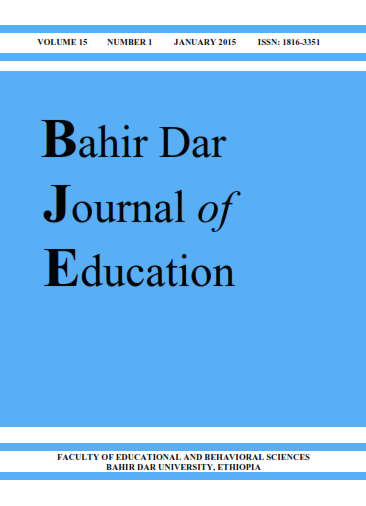Competency-Based Secondary Teacher Education Program in Ethiopia: Potential Opportunities and Obstacles
Abstract
Prompted by increased concern about the competence model for teacher- preparation in Ethiopia, this article discussed the then pre-service Secondary Teacher Education Program that makes visible four different components which are required for competence – to outline the level of achievement that the prospective secondary School teachers must reach to fit the Graduate Teacher profiles. The article explored that government’s influence through the auspices of the Teacher Education System Overhaul (TESO) may lead to a race for standards in which competence statements are employed as an important quality control for aspiring teachers who fit the Graduate Teacher Profiles. However, the article subsequently cautioned that those involved in producing effective teachers should take care in structuring secondary Teacher Education Program that is based on the premise that a competence approach to development and assessing is trouble free. The article further explored the assumption that effective teaching can be ensured simply by isolating particular skills for training, structuring them in a hierarchy that reflects the way that student teachers progress in their ability to teach, and then assessing them using the same schedule of competence statements, must be considered in light of the value-laden nature of teaching. The assumption that competence can be reduced to simple “ticking off†a list of competencies does not confirm that a student is an effective teacher for there are the many influences of contextual factors attending the task of teaching and interpreting its effectiveness. Finally, in drawing a conclusion, the article suggested that in aligning their program with the competence statements contained within the national curriculum, Teacher Education Institutions must not neglect the developmental aspect of the skills that enable student teachers to reach the Graduate Teacher Profiles. Every Teacher Education Institution has to make decisions about the best way to incorporate the statements into their program and assessment of practical teaching.References
Amos, S. & Postlethwaite,K. (1996). Reflective practice in initial teacher education: some successes and points for growth. Journal of Teacher Development, 5(3), 11-12.
Black, H., & Dockrell, W. (1984). Criterion-referenced assessment in the classroom. Edinburgh: Scottish Council for Research in education.
Befekadu, D., & Berhanu, N. (Eds.) (2000). Annual report on the Ethiopian economy (vol. 1). Addis Ababa: United Printers.
Brickhouse, N. (1990). Teachers’ beliefs about the nature of science and their relationship to classroom practice. Journal of Teacher Education, 41(3), 53-62.
Bullough, R. (1987). Accommodation and tensions: Teachers, teachers’ role and the culture of teaching. In J. Smyth (Ed), Educating teachers: Changing the nature of pedagogical knowledge (pp.83-94). London: Falmer Press
Ebbutt, D. & Elliott, J. (1998). Supporting teachers’ professional development in a developing country through practice based inquiry and distance learning: Some key issues. Educational Action Research, 6(2), 205-218.
Darge, W. (2002). The predominance of different sources of stress among teachers in government senior high schools of Addis Ababa, The Ethiopian Journal of Education, XXII(1),1-32.
Dawit, M., & Alemayhu, B. (2001). Preservice teachers’ perception towards professional courses and the efficacy of subject methodology courses in developing pedagogical content knowledge. The Ethiopian Journal of Education, 22(1) 1-32.
Education and Training policy (ETP, 1994). New Education and Training policy of Ethiopian Curriculum in prospect. Addis Ababa: Ethiopia.
Gudmundsdottir, S. (1990). Values in pedagogical content knowledge. Journal of Teacher Education, 41(3), 44-52.
Harrison, J. (1995). A rational for partnership. In V. Griffiths & P. Owen (Eds), Schools in partnership (pp.29-40). London: Paul Chapman.
Hayes, D. (1999). Opportunities and obstacles in the competency-based training and assessment of primary teachers in England. Harvard Educational Review, 69(1), 1-28.
Hodkinson, H. & Hodkinson, P. (1997). Micro-politics in initial teacher education: Luke’s story. Journal of Education for Teaching, 23,119-129.
Ministry of Education (MOE, 2003). Teacher education system overhaul handbook. Addis Ababa: Ethiopia
Reynolds, M., & Salters, M. (1995). Models of competence and teacher training. Cambridge Journal of Education, 25, 349-359.
Rolls, E. (1997). Competence in professional practice: Some issues and concerns. Educational Research, 39(2), 195-210.
Sparkes, A., & Macday, R. (1996). Teaching practice and the micro politics of selfpresentation. Pedagogy in practice, 2(1), 23-22
Thiessen, D. (1992). Classroom–based teacher development. In A. Hargreaves & M. G. Fullan (Eds.), Understanding teacher development (pp.85-109). London: Teachers’ College Press.
Whitty, G. & Willmott, E. (1991). Competence–based teacher education: approaches and Issues. Cambridge Journal of Education, 21, 309-318.
Zeichner, K. & Lars, D. (1999). Democratic teacher education reform in Africa: The case of Namibia. Windhock, Namibia: John Meinert printing,.
Authors who publish with this journal agree to the following terms:
- Authors retain copyright and grant the journal right of first publication with the work simultaneously licensed under a Creative Commons Attribution License that allows others to share the work with an acknowledgement of the work's authorship and initial publication in this journal.
- Authors are able to enter into separate, additional contractual arrangements for the non-exclusive distribution of the journal's published version of the work (e.g., post it to an institutional repository or publish it in a book), with an acknowledgement of its initial publication in this journal.
- Authors are permitted and encouraged to post their work online (e.g., in institutional repositories or on their website) prior to and during the submission process, as it can lead to productive exchanges, as well as earlier and greater citation of published work (See The Effect of Open Access).

